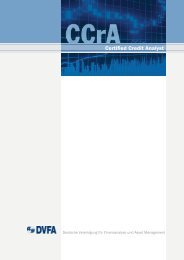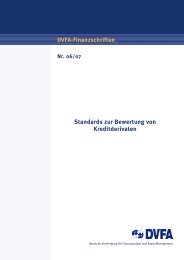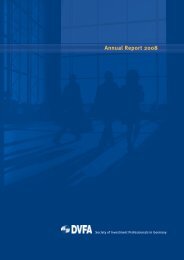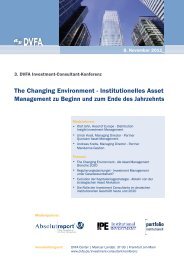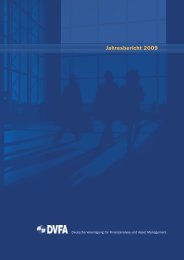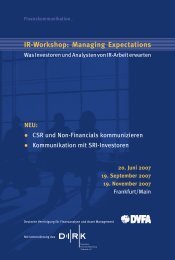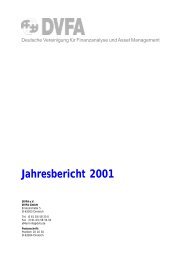KPIs for ESG - DVFA
KPIs for ESG - DVFA
KPIs for ESG - DVFA
Create successful ePaper yourself
Turn your PDF publications into a flip-book with our unique Google optimized e-Paper software.
3357 Tires<br />
<strong>ESG</strong> KPI KPI-Label + Definition<br />
1742 Energy Efficiency E0101 Energy consumption, total<br />
1743 Energy Efficiency E0102 Energy consumption, specific (intensity); Options: per unit of<br />
revenue, per FTE, per unit of production volume (e.g. tonnes of steel)<br />
1744 GHG Emissions E0201 GHG emissions, total (scope I,II, III)<br />
1745 GHG Emissions E0202 GHG emissions, specific; Options: per unit of revenue, per<br />
FTE, per unit of production volume (e.g. tonnes of steel)<br />
1746 Staff Turnover S0101 Percentage of FTEs leaving p.a./total FTEs<br />
1747 Training & Qualification S0202 Average expenses on training per FTE p.a<br />
1748 Maturity of Work<strong>for</strong>ce S0301 Age structure/distribution (number of FTEs per age group, 10-year intervals)<br />
1749 Remuneration S0801 Total amount of bonuses, incentives and stock options paid out in €,$<br />
1750 Remuneration S0802 Total number of FTEs who receive 90 % of total amount of bonuses, incentives and stock options<br />
1751 Remuneration S0803 Key Per<strong>for</strong>mance Narrative (Please answer the questions in max. 500 words) Do you take <strong>ESG</strong><br />
per<strong>for</strong>mance into account in your per<strong>for</strong>mance agreements? How do you integrate <strong>ESG</strong> principles<br />
within per<strong>for</strong>mance agreements in your company and to what extent do you apply them?<br />
1752 Litigation risks V0101 Expenses and fines on filings, law suits related to anti-competitive<br />
behavior, anti-trust and monopoly practices<br />
1753 Corruption V0201 Percentage of revenues in regions with Transparency International corruption index below 6.0<br />
1754 Revenues from new<br />
products<br />
V0302 Percentage of new products or modified products introduced less<br />
than 12 months ago<br />
1755 Innovation V0401 Total R&D expenses<br />
1756 Innovation V0402 Total R&D expenses in monetary terms i.e. currency as a percentage of total revenue<br />
1757 Innovation V0405 Number of patents registered within last 12 month<br />
1758 Innovation V0406 Percentage of patents registered within last 12 month in relation to total number of patents<br />
1759 Innovation V0407 Number of patents due to expire within next 12 month in relation to total number of patents<br />
1760 Innovation V0408 Percentage of patents due to expire within next 12 month in relation to total number of patents<br />
1761 Innovation V0412 Total investments in research on <strong>ESG</strong>-relevant aspects of business such as e.g. eco-design, ecoefficient<br />
production processes, decreasing impact on biodiversity, improving health and safety<br />
conditions of employees or supply chain partners, consulting on integration of <strong>ESG</strong> aspects in change<br />
management, development of products to exploit <strong>ESG</strong> opportunities etc. in monetary terms i.e.<br />
currency as a percentage of revenue<br />
1762 Innovation V0413 Percentage of products or services <strong>for</strong><br />
- increasing eco-efficiency of client applications or operations<br />
- developing and using clean technologies<br />
- offsetting climate change, carbon emissions , resource depletion<br />
- increasing fuel-efficiency<br />
- making <strong>ESG</strong>-relevant products operable<br />
(e.g. smart metering, green building technologies)<br />
- financing of <strong>ESG</strong>-relevant products or services<br />
1763 Innovation V0414 R&D expenses in fuel efficiency and climate change mitigation as a percentage of revenue<br />
1764 Emissions to Air E0301 Total CO2,NOx, SOx, VOC emissions in million tonnes<br />
1765 Emissions to Air E0304 TOP 2 components of emissions to air by environmental importance (according to TRI; PRTR; and<br />
EPER) Rank 1<br />
1766 Emissions to Air E0305 TOP 2 components of emissions to air by environmental importance (according to TRI; PRTR; and<br />
EPER) Rank 2<br />
1767 Waste Scope I E0401 Total waste in tonnes<br />
1768 Waste Scope II E0501 Percentage of total waste which is recycled<br />
1769 Waste Scope III E0601 Hazardous waste total in tonnes total<br />
1770 Waste Scope III E0606 Non-hazardous waste total in tonnes total<br />
1771 End of Product Lifecycle E0901 Percentage of total product output in terms of revenue which has undergone a design <strong>for</strong><br />
1772 End of Product Lifecycle E0902<br />
disassembly design process<br />
Percentage of total product output in terms of revenue eligible <strong>for</strong> remanufacture or re-conditioning<br />
processes<br />
1773 End of Product Lifecycle E0903 Percentage of total product output in terms of revenue which is reused in the manufacturing process,<br />
sold or donated to third parties<br />
1774 End of Product Lifecycle E0904 Degree to which products (on average) can be recycled calculated as a percentage of all materials<br />
used<br />
1775 End of Product Lifecycle E0905 Degree to which products (on average) can be recycled calculated as a percentage of all associated<br />
material costs<br />
1776 Recycling Quota E1401 Number of units of products delivered to company <strong>for</strong> recycling in relation to total output of units<br />
p.a.<br />
1777 Recycling Quota E1402 Products delivered to company <strong>for</strong> recycling in tonnes in relation to total output of units in tonnes<br />
p.a.<br />
1778 Raw Material Reserves E2201 Full day supply of raw material A (B, C, D) in stock<br />
1779 Production Shortfall E2301 Production shortfall caused by material supply constraints in percent (gap between actual production<br />
output and theoretical production output as optimal supply)<br />
1780 Production Shortfall E2302 Monetary impact of production shortfall caused by material supply constraints in monetary terms i.e.<br />
currency<br />
© <strong>DVFA</strong> April 2010 ALL RIGHTS RESERVED. No part of this publication may be reproduced, stored in a retrieval system, or transmitted, in any <strong>for</strong>m or by any means, electronic,<br />
mechanical, recording, without the prior permission of the copyright holder.<br />
79



